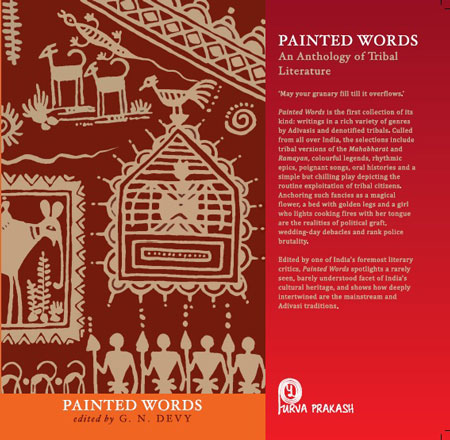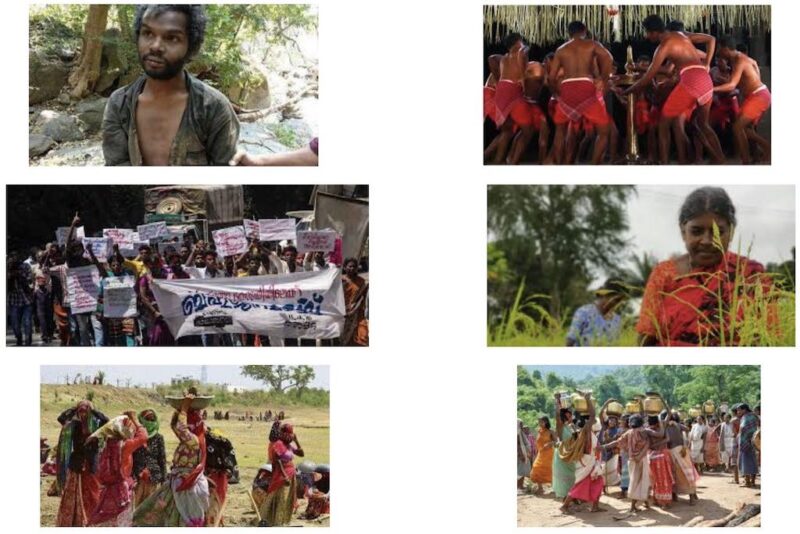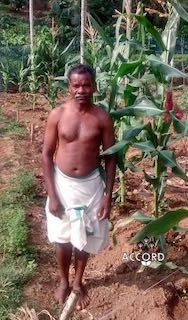“The tribal households traditionally had a backyard garden that had multiple, multilayered and multipurpose indigenous trees, plants, herbs, and shrubs. […] The produce from this small garden was sufficient to meet the dietary and nutrition needs of a family for an entire year.” – Learn more about food crops that are resistant to pests, grow on poor soils, flourish under changed climatic conditions and offer high nutritive value | Food distribution >>
The tribal food basket has always been diverse and nutritious, including maize, minor millets like kodo and kutki, oil seeds like ramtila, along with fruits, leaves, rhizomes, mushrooms, meat and fish. […] We have pushed them out of their complementary relationship with ecology, way of life and time-tested nutrition >>
The tribes in Attappady are classified into three categories; Kurumba, Irula and Muduga. Kurumbas live deep inside the forests in 19 settlements of Pudur. Whereas, most of the Irula and Muduga populations live on revenue lands of Pudur, Agaly and Sholayur. A few among the settlements of Irula and Muduga are in forest lands. […]
There are 149 settlements for Irula and 24 for Muduga. In total there are 192 settlements.
A brief history of Attappady
The people living in revenue lands are the victims of land alienation. Whereas, the tribes inside the forests get land for cultivation from the forest department but the custodian of the land remains the forest department only.
The entire Attappady region comprises 1,80,000 acres which belonged to Thathunny Mooppil Nair till 1960. Soon after the formation of the state of Kerala, nearly 35,000 acres of land was identified as reserve forest and the remaining became revenue land. The tribes of Attappady were given the right to live on the land. Meantime, many of them living in revenue land received pattayam. Forest department provided land for cultivation for tribes inside the forest as well. […]
Source: “Stripped of land, tribes in Attappady fight mafia and corrupt officials”, Mathrubhumi, 4 November 2021
URL: https://english.mathrubhumi.com/mobile/news/kerala/stripped-of-land-tribes-in-attappady-fight-mafia-and-corrupt-officials-attappady-infant-death-nanchiyamma-1.6239074
Date Visited: 6 November 2021
“Opportunities are limited, jobs are scarce and so far ‘development’ remains a slogan. There’s a lot that is being done to keep caste going in spite of saying that we are trying to erode caste. We are, of course, dodging the real issue. It’s true that there has been a great deal of exploitation of Dalit groups and OBC’s [Other Backward Castes] in past history; making amends or even just claiming that we are a democracy based on social justice demands far more than just reservations. The solution lies in changing the quality of life of half the Indian population by giving them their right to food, water, education, health care, employment, and social justice. This, no government so far has been willing to do, because it means a radical change in governance and its priorities.” – Romila Thapar (Emeritus Professor of History, Jawaharlal Nehru University) in You can’t run disciplines on the basis of the notions that particular governments may have”: An Interview with Romila Thapar by Nikhil Pandhi (Caravan Magazine, 7 October 2015) | Learn more >>
“The theoretical debate on caste among social scientists has receded into the background in recent years. [C]aste is in no sense disappearing: indeed, the present wave of neo-liberal policies in India, with privatisation of enterprises and education, has strengthened the importance of caste ties, as selection to posts and educational institutions is less based on merit through examinations, and increasingly on social contact as also on corruption.” – Harald Tambs-Lyche (Professor Emeritus, Université de Picardie, Amiens) in “Caste: History and the Present” (Academia Letters, Article 1311, 2021) | Learn more >>
[…] Wise men coming here [Agali Community Health Centre in Attappady, Palakkad district, Kerala] from the governments of Delhi and Thiruvananthapuram have declared that the women do not know how to feed their children properly, they must be educated about nutrition, exclusive breast feeding and weaning. The deaths are due to ignorance, they say. […]
The third National Family Health Survey in 2005-2006 showed that at the all-India level, 46.6 per cent of tribal women and 41.1 per cent of Dalit women have a body mass index that is below normal. Of these, an alarming 21 per cent of tribal women and 18.5 per cent of Dalit women are moderate/ severely thin. If Attappady is an indication, there has been little improvement. […]
Before Kavitha was born, her family owned land and grew millets and, sometimes, pulses which helped maintain a certain level of nutrition. As many health officials say, it is not a lack of knowledge but loss of land, which is an important factor behind poor nutrition. In Attappady, as in other parts of India, dispossession of tribals from their land by various methods of land grab has occurred. There is a consequent forced dependence of tribals on a now weakened public distribution system. […]
If this [high incidence of infant deaths due to malnourishment] can happen in Kerala, what of those States where governments equally committed to neo-liberal policies do not even have a proper monitoring system? […]
India along with the sub Saharan Africa region is the only country in the world where the number of very poor people has registered an increase in the last 30 years. According to a recent World Bank study (The State of the Poor: Where are the Poor and where are the Poorest), India now accounts for one-third of the world’s poorest people — that is those earning around 87 cents, less than Rs 50 a day. In 1981, one-fifth of the world’s poorest people lived in India; in 2010, the numbers increased to one-third, around 400 million. Clearly, the government has to make drastic changes and reversals in its present policies to address the issues of deprivation. It should draw the right lessons from the Attappady tragedy because the deaths could have been prevented had the policies been different. […]
Source: “Gruel, rice and tamarind water” by Brinda Karat, The Hindu, Opinion, 2 July 2013
Address : https://www.thehindu.com/opinion/lead/gruel-rice-and-tamarind-water/article4870315.ece
Date Visited: 5 December 2021
A year after a large number of child deaths were reported from Attappady owing to malnutrition, an official survey held in the past two weeks has found that 572 children below the age of five in the tribal belt still remain malnourished.
As per the findings of the survey conducted by the National Rural Heath Mission (NRHM), the condition of 127 of these 572 children remains extremely serious and the rest are in the high-risk group deserving immediate attention.
This is happening at a time when the Central and State governments are pumping in about Rs.500 crore under different special packages in the region to fight poverty and malnutrition and for employment generation and improving basic living standards. […]
Attappady has 10,000 tribal families belonging to the Irula, Muduga and Kurumba tribes, living in 192 oorus (settlements) scattered in the three panchayats.
The report attributes the reasons for malnutrition to marginalisation and impoverishment of Adivasi communities, lack of food and nutritional security, and poor health-care and supplementary nutrition services. […]
Source: “Malnutrition continues to stalk tribal children” by K. A. Shaji, The Hindu, PALAKKAD, 15 June 2014
Address : https://www.thehindu.com/news/national/kerala/malnutrition-continues-to-stalk-tribal-children/article6115489.ece
Date Visited: 5 December 2021
Schemes launched by the government in Attappady have reduced the area’s tribals to wage labourers and has disempowered them
Attappadi stands testimony to how land encroachment by outsiders and the mainstream development process of the government could deeply shatter an erstwhile self-sustained community. […]
“Despite spending crores, these projects could not make the tribes a self-reliant community. Instead, they made tribals, who were cultivators, mere wage labourers,” points out P R G Mathur, anthropologist and former director of Kerala Institute for Research, Training and Development Studies for Scheduled Castes and Scheduled Tribes (KIRTADS), a state government organisation based in Kozhikode.
These projects, incomplete or completed, paved way for the emergence of a strong nexus of contractors-politicians-officials in the block. Politicians became contractors, contractors became politicians, and they became the people’s representatives. They did not have any empathy for the tribal communities, points out K A Ramu, convener of Thampu, an organisation working among adivasis in Kerala. […]
More than that, over the years, adivasis have become a minority in Attappady and they are living amidst of the settlers, contractors and politicians. Besides, the government never took them into confidence and made no special efforts to empower them as the decision makers. […]
“The poverty and malnutrition among the tribes itself is a testimony of the failure of the development projects,” points out Ramu. According to him, the only way forward is to take tribal communities and organisations into confidence before planning anything for them. Now the community is shattered. “So the beginning must be empowering oorukoottams once again,” he says. None of the ministers who visited Attappady in the wake of infant deaths and announced packages has bothered to meet and consult the tribal organisations, he says.
Source: “Victims of development’ by M. Suchitra, Down to Earth, 14-7-2013 Down To Earth
Address : https://www.downtoearth.org.in/content/victims-development
Date Visited: 17 December 2021
“It was assumed that tribal people have same health problems, similar needs and hence the uniform national pattern of rural health care would be applicable to them as well, albeit with some alteration in population: provider ratio. The different terrain and environment in which they live, different social systems, different culture and hence different health care needs were not addressed.” – Abhay Bang in Report of the Expert Committee on Tribal Health >>
The Hindu, July 6, 2013
Even after 65 years of independence, the infants of Attappady are dying of malnutrition. The tribal communities, alienated from their lands in the name of development, are beyond the pale of officialdom. Will the Centre’s food security move ensure basic entitlements to these people on the margins? Photos: The Hindu
Source: Hunger: Attappady’s silent killer – The Hindu
URL: https://www.thehindu.com/news/national/kerala/hunger-attappadys-silent-killer/article4888794.ece/photo/1/
Date Visited: 17 December 2021
State governments often show great concern for provision of infrastructure for economic growth but fail to see where it all begins — in a school system that produces the workforce of the future. Without even being able to guarantee children a safe meal, their assertions are meaningless.
Source: “The poisoned plate”, The Hindu, Editorial, 18 July 2013
Address : http://www.thehindu.com/opinion/editorial/the-poisoned-plate/article4924872.ece
Date Visited: 5 December 2021
[Bold typeface added above for emphasis]
Learn more about the tribal communities mentioned in this post
Tips for using interactive maps
Toggle to normal view (from reader view) should the interactive map not be displayed by your tablet, smartphone or pc browser
For details and hyperlinks click on the rectangular button (left on the map’s header)
Scroll and click on one of the markers for information of special interest
Explore India’s tribal cultural heritage with the help of another interactive map >>
See also
Adverse inclusion | Casteism | Rural poverty
Demographic Status of Scheduled Tribe Population of India (Census figures 2011)
Fact checking | Figures, census and other statistics
Human Rights Commission (posts) | www.nhrc.nic.in (Government of India)
Search tips | Names of tribal communities, regions and states of India
“What is the Forest Rights Act about?” – Campaign for Survival and Dignity
“Who are Scheduled Tribes?” – Government of India (National Commission for Scheduled Tribes, NCST)

Tribal Literature by G.N. Devy >>
Free eBooks & Magazine: Adivasi literature and languages >>
“India, a union of states, is a Sovereign, Secular, Democratic Republic with a Parliamentary system of Government. The President is the constitutional head of Executive of the Union. In the states, the Governor, as the representative of the President, is the head of Executive. The system of government in states closely resembles that of the Union. There are 28 states and 8 Union territories in the country. Union Territories are administered by the President through an Administrator appointed by him/her. From the largest to the smallest, each State/UT of India has a unique demography, history and culture, dress, festivals, language etc. This section introduces you to the various States/UTs in the Country and urges you to explore their magnificent uniqueness…” – KnowIndia (Government), States and Union Territories (Visited: 2 September 2023)
Learn more about India’s 28 States and 8 Union Territories – From Andhra Pradesh to West Bengal | Nutrition >>
See also
Biodiversity and development – Kerala
Childhood – Kerala | Childrens rights: UNICEF India | Safe search
Childrens rights: English or Malayalam (UNICEF India)
eBook | Background guide for education
Education and literacy | Right to education
Kerala | State wise ST list (Scheduled Tribes)
Recommendations by the Expert Committee on Tribal Health
Tribal schools and educational projects – Kerala
Video | M.S. Swaminathan on Biodiversity and the sharing of resources
Video | Trailer to “Have you seen the arana?” – Kerala
Vulnerable tribal groups – Kerala
Women | Safe search | President Droupadi Murmu on women’s empowerment

